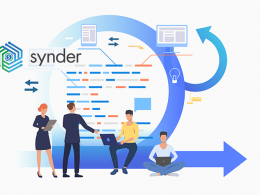When starting a business, all the paperwork and accounting may seem daunting. You have to analyze every step and decision you’ve made to plan where you want to be in the future and what you need to do right now. To achieve your goals, you’ll need to prepare numerous reports, establish, evaluate, and strengthen external partnerships that generate new growth, create a strategic mapping to increase confidence in your actions, and the list goes on!
No matter how large or small your business is, the good news is, managerial accounting will help you gain profit. This type of accounting aims mainly at forecasting and making long-term business decisions, and is used to ensure your company’s financial health.
It focuses not only on financial statements like the P&L statements but also helps build connections across business units and design systems, enhance business performance, and implement innovative strategic measures. So what’s managerial accounting, and why is it crucial for small business owners?
Contents:
2. Major tasks of managerial accounting
3. How does financial accounting differ from managerial accounting?
4. Financial accounting vs. managerial accounting
- Difference #1. Target audience
- Difference #2. Outlook
- Difference #3. Scope
- Difference #4. Priority
- Difference #5. Necessity
- Difference #6. Rules
What is managerial accounting?
Managerial accounting, also known as management accounting, involves identifying, measuring, interpreting, and communicating information to management to assist them in planning, decision-making, and risk management.
As the company establishes a strategy or objective, it needs well-thought-through approaches to achieve the results. Management accountants can design specific systems so that actions lead toward achieving the goal of that strategy or intent.
Small business owners need a straightforward and critical opinion and accurate information about their business to grow it successfully. Don’t worry if at university you haven’t opted for a career in accounting, managerial accountants are there to help you. They can use financial statements or raw data to take relevant, cost-effective, and accurate information and put it into a context to effectively analyze it and make quick decisions.
How managerial accounting looks at data
Usually, management accountants analyze three types of information:
- Strategic. It’s used for long-term planning (beyond one year) and belongs to the data of the highest management level.
- Tactical. It’s middle-level management data that is used for monthly up to annual planning and control.
- Operational. This one controls information in the short-term period (from a day to a week, up to a month) and stands on a junior level of management.
With such a division, managerial accounting reports on the business, dividing it into smaller units to better manage each of them according to the following scheme:
It separates cost and revenue centers into departments to control everything better and calculate the profit center out of the two previous centers. Then it’s time to analyze the investment center to decide whether or not to invest money in the business. It’s a so-called strategic insight for future decisions.
What managerial accounting focuses on
Managerial accounting also investigates three main topics in running a small business:
- Reviewing products. This one is mostly about providing financial and business-crucial statistics about all business processes.
- Launching new products. A managerial accountant plays a support role in investigating all the necessary information about new products.
- Staffing. These are the decisions around hiring new employees and setting wages.
It’s a good practice to investigate the information relevant to your type of small business to produce a 100% profit out of all the decisions that have been made and create the most accurate reports.
There are three major types of companies: service, merchandising, and manufacturing services. The main difference between them is in the integral parts of the inventory accounts. They’re raw materials, products in progress, and finished goods. For example, raw materials aren’t always iron or plastic as the spheres can be different, starting with IT service firms and ending with healthcare organizations.
Major tasks of managerial accounting
Previously we’ve discussed management accounting from a broader perspective, but what are the main tasks of this type of accounting? Let’s look at the top four:
1. Planning. Mostly it’s connected to the business budget, money flow, how much money the company spends in general on manufacturing, and which part of the money goes to either marketing or the cost of products. There are two main types of planning for your business growth: long-run and short-run. As was mentioned before, long-run planning is strategic and it looks at/considers the possibilities for the future in three to five years. Whereas short-run planning is primarily concerned with production orienting and process prioritizing, taking into account operational budgeting or profit planning.
2. Controlling. This allows small business owners to compare the actual results to the originally expected ones. The data is then used in the evaluation process to compare against the budgets and deviations from the standards. These deviations are called variances, so it’s kind of a variance analysis that helps you analyze why, for example, the actual results are higher than expected.
3. Decision-making. This task is not permanent and is only relevant when necessary. But still, it’s a crucial point at times when a decision needs to be made as quickly as possible. It answers questions such as whether the business owner should or should not perform a particular action. Also, the task is to make sure that the revenue won’t be too different from the costs spent on manufacturing the products.
4. Performance evaluation. As everyone knows, any firm has a bunch of different divisions. Each of them is responsible for particular tasks within the company. For example, Sales Teams are responsible for the sales rates, Marketing Teams — for the advertising of the product, etc. Performance evaluation helps determine the profit of every division and increases the company’s income statements.
Wrapping up the information above, planning involves looking into the future and controlling through managing the present situation in the company. Simultaneously, evaluation relates to looking at and learning from the past.
How does financial accounting differ from managerial accounting?
Despite reading the previous paragraphs dedicated to the definition of management accounting, differentiating between financial and managerial accounting may still be challenging. Let’s start with defining financial accounting.
What is financial accounting?
Financial accounting is the process of recording, summarizing, and analyzing an entity’s financial transactions and reporting them in financial statements to its existing and potential investors, lenders, and creditors. The banking sector heavily relies on financial accounting, meaning that the financial statements used by banks are uniform and must adhere to a set of rules. Financial accounting reports need to follow strict guidelines and principles to comply with regulatory bodies.
Financial statements are used to look back at the data and are mostly concerned with the past, while managerial accounting is mostly concerned with the future. However, financial accounting vs. managerial accounting isn’t always so clear-cut. For example, if the financial statements are being used for the purpose of investing or applying for insurance, they still fall under financial accounting even though they’re surely looking toward the future.
Financial accounting vs. managerial accounting
There are some guiding principles that allow us to differentiate managerial accounting from financial. Let’s take a more detailed look.
Difference #1. Target audience
It becomes pretty evident that financial and managerial accounting define the process of collecting financial information and presenting it to the target audience in the form of financial reports. The target audience for managerial accounting is small business owners themselves who help to establish a more profitable environment within a company. In contrast, financial accounting orientates itself toward potential investors and lenders.
Financial accounting is used in the external arena to compare one company to another, while managerial accounting is a more internal process that impacts performance and profitability.
Difference #2. Outlook
Financial accounting focuses more on the previous transactions and events that happened in the company. It puts together the reports (income statements and balance sheets) to sum up all the money transferred over a period of time. Managerial accounting concentrates on information in the reports which are focused on the future. They usually include money forecasts or lists of alternatives.
Difference #3. Scope
Financial accounting is used to understand and observe the big picture of the whole business and see what else can be done compared to other companies. The task of a financial accountant is to find unique features and establish them within their own company to take advantage of competitors. So it has a broader scope.
Managerial accounting, on the other hand, analyzes the work within the company. It splits the big picture from financial accounting into different segments to provide them with individual reports. It’s not about how competitive the company is, but how profitable each division is.
The significance of this difference is that the information gathered in financial accounting must be only financial, while management accounting is presented by both financial and non-financial reports.
Difference #4. Priority
In financial accounting, information needs to be objective and precise. Every calculation needs to be made with 100% accuracy so that the statistics in the global arena will be useful.
Managerial accounting is more about being relevant and timely. This information is valuable at a particular time.
Difference #5. Necessity
As previously mentioned, financial accounting is a must at all times, especially when you have a small growing business. But does that mean managerial accounting isn’t required? You may think so, but once you get hit with unexpected troubles that need to be solved quickly, you’ll understand the importance of management accounting.
When it comes to the decision-making strategy, this type of accounting becomes your main priority.
Difference #6. Rules
In financial accounting, the rules are set by the Financial Accounting Standards Board (FASB) or by the International Accounting Standards Board (IASB). The standards set by FASB are collectively called Generally Accepted Accounting Principles (GAAP) and IASB standards – International Financial Reporting Standards (IFRS). These rules must be followed when companies are filing reports for external users.
It’s essential to strictly follow all the regulations and rules to avoid any misinformation.
In the case of managerial accounting, there are no such heavily regulated rules. Unlike financial accounting, managerial accounting focuses on both the summary and details.
Let’s sum up all the differences in a table:
| Financial Accounting | Managerial Accounting |
|---|---|
| #1. Target Audience | #1. Target Audience |
| External | Internal |
| #2. Outlook | #2. Outlook |
| Past | Future |
| #3. Scope | #3. Scope |
| Broad | Narrow |
| #4. Priority | #4. Priority |
| Objective and precise | Relevant and timely |
| #5. Necessity | #5. Necessity |
| Essential when business grows | Valuable when coming to the decision-making strategies |
| #6. Rules | #6. Rules |
| Heavily regulated | Less regulated |
It must be concluded that neither financial nor managerial accounting is less essential than the other one. They both play a significant role in growing a small business, and the owners need to pay attention to both of them to increase the company’s operational efficiency.
Analysis and reports
Managerial accounting is a data-driven look at how to grow a small business and which actions should be taken. It often involves various financial metrics that are used to create a detailed report, including revenue, sales, operating expenses, and cost controls.
Types of managerial accounting analysis
As already said, managerial accounting splits the whole company into different divisions, analyzes, and produces reports about each sector. Let’s take a look at the most significant types of managerial accounting analysis:
- Margin analysis. It analyzes the incremental benefit of increased production. Here we can also mention the break-even analysis, which involves contribution margin calculation and examines cost volume profit relationships in the management planning process. Knowing the break-even point can help to assess the risk of selling a new product, setting sales goals and commission rates, deciding on marketing and advertising strategies, and making other similar operating decisions.
- Constraint analysis. It indicates the limitations within a sales processor or production line. It helps to find out where the constraints occur and calculate the impact on cash flow, profit, and revenue.
- Capital budgeting. Managerial accounting uses budgets to quantify the business plan of operations and to make decisions quickly. Capital budgeting helps a company decide when, where and how much money to spend based on financial data. The goal is to use the budget to help make short-term operational decisions that will help to increase the company’s performance. The process involves calculating the net present value (NPV) and internal rate of return (IRR).
- Trend analysis and forecasting. The decisions are made on the basis of previous information like historical pricing, sales volumes, geographical location, customer trends, etc. Thus, managerial accounting helps to calculate and project future financial situations.
It’s worth mentioning activity-based costing techniques that help in deciding which customers are more profitable. These allow business owners to target customers with their advertisements.
- Product costing and valuation. Here, managerial accounting takes a look at the actual costs of products and services. Often a relevant cost analysis is used, and it focuses on examining the costs that differ between advertising alternatives for each product, ignoring standard costs to develop the most profitable one.
Types of managerial accounting reports
After examining and accumulating all the information needed, managerial accounting proceeds to sum everything up in reports. These reports may be about order information, project, or competitors, but let’s define the three major types:
- Accounts receivable aging reports. This report breaks down the remaining balances of the clients into specific periods, which allows managers to identify the debtors and indicate issues in the company collection process.
- Performance reports. They consist of performance recordings of a whole company, each department, and each employee. Usually, this type of report is made at the end of each term. It can show flaws in workflow setups if a whole department is somehow not performing to a specific capacity.
- Cost reports. These managerial accounting reports include all raw material costs, overhead, labor, and any added costs that need to be considered. These totals are divided by the amounts of products produced and summarized. These reports help to estimate and manage profit margins.
Bottom line
Managerial accounting helps to implement day-to-day information and analyze the workflow within the company. This allows the owner to set up the most profitable plan to follow during a specified period.
The one thing that no owner should forget about is that reports can’t make the decision for you. It’s up to a person to analyze the results and come to a conclusion about the next steps.
Since the decision-making process requires lots of effort and concentration, it’s important that the amount of time spent on gathering the information connected to the sales, costs, and transactions, is minimized.
As a small business owner, you might be interested in how accounting software can help you and your business. Synder can save you time and stress to focus on the more important aspects of management. You can start a free trial and try synchronizing transactions with your accounting platform. On the website, you also have the opportunity to register for a demo so that you can see how the software works and ask our experts any questions.
Give Synder a chance to forever transform the way you see accounting!







Nice knowledge-gaining blog. This post is the best on this valuable topic. I like your explanation of the topic and your ability to do work. I found your post very interesting.
Thank you so much!